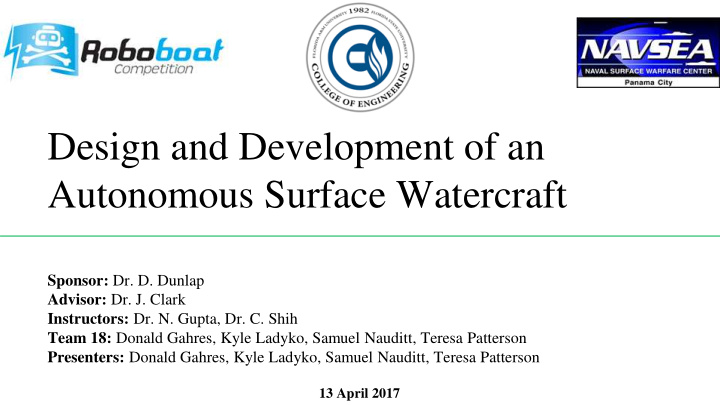



Design and Development of an Autonomous Surface Watercraft Sponsor: Dr. D. Dunlap Advisor: Dr. J. Clark Instructors: Dr. N. Gupta, Dr. C. Shih Team 18: Donald Gahres, Kyle Ladyko, Samuel Nauditt, Teresa Patterson Presenters: Donald Gahres, Kyle Ladyko, Samuel Nauditt, Teresa Patterson 13 April 2017
Overview ● Project Introduction ● Prototype Design ● Prototype Construction: The Boogie-Boat ● Finalizing: The Party-Barge ● Overall Results ● Scheduling ● Resource Allocation ● Summary ● Q & A 2 Presenter: Teresa Patterson
The Competition ● AUVSI International Roboboat Competition ● Objective: ○ Design an unmanned surface vehicle to perform a series of tasks ● Mimics tasks being studied and implemented by port and coastal security forces 3 Presenter: Teresa Patterson
Competition Tasks ● Weight/Thrust Measurement ● Basic Navigation ● Obstacle Avoidance ● Automated Docking ● Interoperability ● Acoustic Beacon/Pinger Location ● Return to Dock 4 Presenter: Teresa Patterson
Real World Applications of Competition Tasks ● Types of Mines ○ Contact Mines ○ Influence/Acoustic Mines ● Buoy Navigation ○ Mimics field of contact mines ● Acoustic Pinger & Interoperability ○ Deployment of mine-hunting sonar systems ■ AN/AQS-20A ■ AMNS ● 2017 Predicted Drone Task ○ Northrop Grumman ALMDS 5 Presenter: Teresa Patterson
Project Scope ● Goal Statement: Create a lightweight surface vehicle capable of maneuvering a course autonomously with a focus on obstacle avoidance, waypoint navigation, and color and shape recognition while remaining versatile for later subsystems to be added. 6 Presenter: Teresa Patterson
Conceptualization ● Brainstormed various small watercraft designs ● Researched the monohull, catamaran, and trimaran platforms ● Team read through past teams’ reports including the winners of the competition Catamaran Hull Trimaran Hull Monohull 7 Presenter: Donald Gahres
Design Selection ● Catamaran hull is more stable and easier to build ● Has been successful in past for multiple teams ● Fixed variable speed thrusters ● Differential thrust ● Electronics placed for easy access ● Allows for multiple systems to be added 8 Presenter: Donald Gahres
Prototyping ● Team 18’s first “funky prototype” ○ Boogie board monohull ○ Two thrusters ○ Initial Colored Object Detection tested ○ Manual control tested ● Prototype allowed team to see how subsystems interacted with each other ○ i.e vision with motion control 9
Results of Prototype Tests ● Two prototype wet tests performed ○ Autonomous channel marker navigation achieved ○ Subsystem integration successful ○ Manual control successful ● Prototype issues ○ Changing color values at dusk ● Changes made: 10 ○ User-input color selection
Party-Barge Construction: Hull ● Compression fit ● Versatile 8020 platform ● Waterproof access hatches ● Dual thruster installation ● Weight: ○ Currently: 70 lbs ○ Future teams can iterate to obtain bonus points when attending competition 11 Presenter: Donald Gahres
Party-Barge Construction: Electronics Housing ● Large container chosen for ease of organization and later versatility ● All electronic components attached to a raised acrylic platform. ● Electronic housing remains organized and capable of adding more electrical components 12 Presenter: Donald Gahres
CAD Modeling 13 Presenter: Donald Gahres
Mechatronics: Device Layout 14 Presenter: Kyle Ladyko
Mechatronics: Manual and Color Based Navigation ● Can be controlled via Xbox controller ● Ability to traverse forward, reverse, and perform zero-point turns. ● Uses HD webcam mounted on front ● Utilizes OpenCV to search for objects based on their color and relative size ● Throttle thrusters to aim for midpoint of buoy pair using feedback control 15 Presenter: Kyle Ladyko
Mechatronics: Obstacle Avoidance ● Manufactured rotating LIDAR assembly to map environment and obstacles ● Achieved centimeter level positioning using Real-Time Kinematic GPS ● Integrated tilt-calibrated IMU to account for waves on surface ● Utilized Vector Field Histogram algorithm for obstacle avoidance and path planning ● VFH is computationally less costly than previous in-work method of SLAM. 16 Presenter: Kyle Ladyko
Testing Results Competition Party-Barge Test Description Status Constraints Performance Vehicle Weight > 140 lbs 70 lbs Pass Vehicle Buoyancy Positively Buoyant Positively Buoyant Pass Vehicle Size <= 3ft x 3ft x 6ft 3ft x 3ft x 5ft Pass Watertight Hull None Yes Pass Channel Marker Navigation Required Task 80% Pass Buoy Field Navigation Required Task 60% In Progress Thrust Output > 0 lbf 3 lbf Pass 17 Presenter: Kyle Ladyko
Video 18 Presenter: Kyle Ladyko
Challenges Faced ● Team & time management ○ Especially in the winter months when daylight was shorter ● Integration of code ○ Autonomous control ○ Manual control bugs ● LIDAR ○ Path planning, functionality of the LIDAR ○ Attachment to boat ○ Poor connections ● Recognition of hue and saturation values ○ Ongoing 19 Presenter: Samuel Nauditt
Lessons Learned ● Scheduling for testing ● Early prototyping allowed for ample time to correct issues ● Familiarity with autonomous systems ● Split the group more and have an even divide on who is given what task ○ Mechanical work vs. Mechatronics work 20 Presenter: Samuel Nauditt
The Future of Roboboat ● Further refinement of autonomous systems ● Implementation of impact detection and subsystems for future competition tasks ● Look into cooling systems for the electronics housing ● Iteration of weight ● Install LIDAR 21 Presenter: Samuel Nauditt
Resource Allocation Roboboat Budget Breakdown ● Initial Budget: $2000 ● Remaining Budget: ~$1000 ● Resources from Robosub: ○ Thrusters Electrical 36% ○ Camera 50% Hull ○ Electronics Test Setup ○ Raw materials Remaining ● Suggestions: 12% ○ Pre-built LIDAR ○ Router ○ External computer screen 2% 22 Presenter: Samuel Nauditt
Summary ● Successfully built a positively buoyant watercraft that can: ○ Avoid buoys and channel markers autonomously ○ Be controlled manually ○ Be easily iterated by future teams for different competition tasks ● Future work: ○ Integration of future tasks with current autonomous logic ○ Iteration of watercraft weight to score bonus points during competition ○ Integration of drone systems for future tasks 23 Presenter: Samuel Nauditt
Questions? 24 Presenter: Samuel Nauditt
Recommend
More recommend